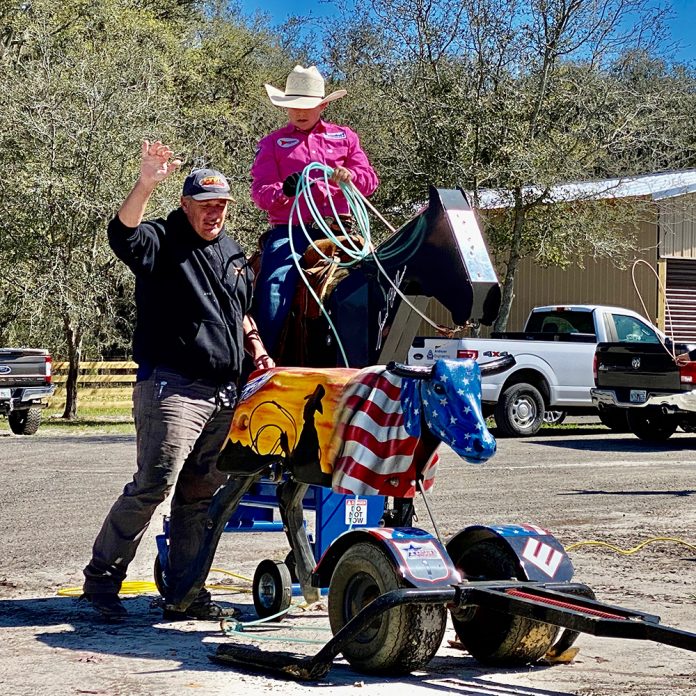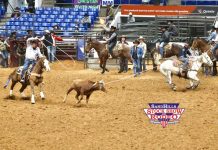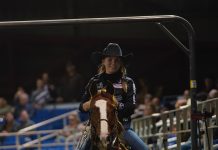I’ve reached a new stage in life where competition is no longer my focus, but it is for my kids. Teaching your kids can be tricky. My goal is to help them eliminate unnecessary steps in their career. There’s a learning process when rodeoing for a living and I want to help them shorten that process.
Hali is now 21, and she’s had a very successful career in Breakaway since she turned 18. Breakaway is a young sport and has become popular nationwide in the last few years. In the past breakaway in rodeos was sporadic and mostly in the northwest or the east. Now it’s a nationwide event with incredible opportunities.
I expect breakaway to change a lot in the next three to five years with a lot of girls going fast. We’re seeing a lot of girls enter the breakaway ropings at young ages, and it’s become a sport for all girls. Unlike barrel racing, girls can be competitive without finding a super expensive horse or a “diamond in the rough.” It takes a special horse to win in the barrel racing at the open level. Open barrel horses can sell from $100,000 to $750,000 and a few even more than that. Breakaway is not at that level yet, but there are lots of girls looking for breakaway horses. It’s a lot simpler to train a breakaway horse to be competitive than to train a barrel horse to win on.
With this new popularity, there are more opportunities for young girls to have a chance at making a living breakaway roping. My daughter has an opportunity I never thought she’d have. I’m so happy for her with the PRCA rodeos, having a chance to compete for $50,000 at Houston, $100,000 at the American, $50,000 at Calgary Stampede and the Kimes Million Dollar Breakaway, where she won over $100,000 last year. These are huge opportunities.
Gabe turned 18 in October. He was a #9 heeler at a young age and didn’t have many opportunities to rope besides roping against the open guys. He had a #6 head card, and we started having conversations about him heading versus heeling. It was a slow transition to get him to understand the importance of learning to head correctly. As a header he has an opportunity to have more control over his future. In my opinion there are more heelers you can pick that will make the NFR than there are headers. As a header, there are more factors that contribute to the success of the team. #1: Horsepower is a huge factor; #2: How much ability you have with your rope.
Now days there are lots of guys who can reach, and the heading world is very competitive. I’ve told my son if he learns to head correctly, and ride his horse correctly, he has a good chance to control his future. The header is the one who takes most of the risk, has the responsibility of figuring out the start, finding out what the steer does, and making a plan of how to execute the run. If you can learn to reach, set up and handle the steer, and make the heelers job easy, you won’t have a problem finding a partner.
I told him this is a two-year plan. We still have a long way to go with his heading, but I’m proud of his progress. He can do the drills on the ground that I do with my clients as fast, or faster, than I can. On our Speed Trainer drills, he caught the dummy at 27’ with a 31’ rope. I don’t normally practice past 25’ because you don’t have enough rope to dally with, but he was able to out-reach me. He has me by two or three inches in height and arm length. That’s a huge advantage when you’re trying to rope with a 31’ rope and throw it 27.’ You’re dealing with inches. There are still a lot of things for him to learn.
I’m grateful my kids chose rodeo as a profession—it allows me to support them both in and out of the arena. Success in rodeo isn’t possible without sponsors, and just as mine helped me win eight world titles, my kids now have incredible sponsors backing their careers. A huge thank you—we couldn’t do it without you!
We’ve been very busy with lessons. I’ve had a lot of headers and a few heelers. But an addition to my training arsenal I’m excited about is the 40’ x 60’ building at the end of my arena. It has a full kitchen, bathroom and shower, and a huge flat screen. We also have a Speed Trainer in the building. I use software on the Speed Trainer where I can film myself or the client and put them side by side and go frame by frame and break down the things we’re working on. Like being able to reach, ride your horse, use your legs. It’s really made teaching so much better. Clients rope, then watch it on TV, and the app shows a skeleton following their feet and hands. We’re able to see details that make it much easier for them to improve.
You can’t improve if you don’t understand what you’re doing wrong. That’s where the video camera comes into play. Being able to study what’s going on frame by frame makes a huge difference. Often, even with high numbered ropers, they’re trying to fix a problem, but they’re not addressing the cause. Going frame by frame it’s easier to see the root of the problem. There are lots of reasons we split the horns or wave it off. Watching the video helps pinpoint the root cause. As a teacher this is an invaluable tool for me to help my students eliminate wasted time and runs.




